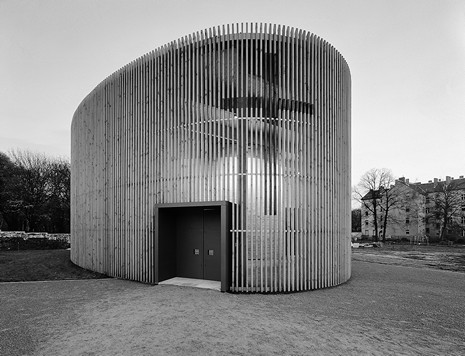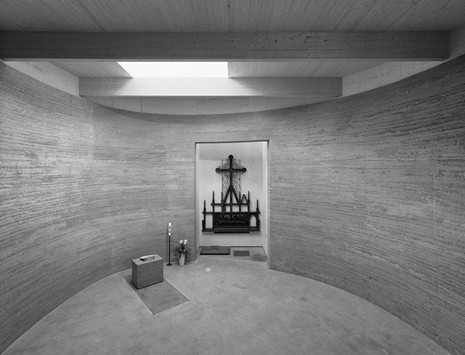Description
The chapel stands where from 1961 until 1989 the wall between East and West Berlin once ran, exactly on the spot where Gotthilf Ludwig Möckel’s neo-Gothic Church of Reconciliation once stood before it was demolished in 1985. The central theme of this partly solid, partly fragile architecture, which consists of a high oval volume for the church service and a low rectangular bell frame, is the history of the political and religious transformation of this place.
The design of the inner container began with a circle as the most compact form of gathering. By stretching and bulging this form, a hint of vestibule and choir is created. The specific dynamism of this almost 9 metre high and 18.5 metre wide chapel derives from the intersection of two axes: the west-east axis that characterises church architecture since its beginnings, northeast to southwest axis that runs parallel to the central axis of the earlier church.
The first of these two axes is marked by a square “rose” visible high up on the west wall and the rammed earth block of the altar in front of the east wall. At the end of the second of these two axes, one sees an illuminated niche with a dark wooden artefact from the original church that depicts the Last Supper of Christ and the Disciples. The eye wanders between the vanishing points of both these axes as it attempts to shift the altar table rightwards beneath the retable and the retable leftwards over the altar table. This separation of the two ritual objects is particularly apparent from the entrance at the rear of the space and from the wooden organ loft.
The preparation of the material and construction was overseen by Martin Rauch. Rammed earth, a mixture of earth, brick grit and straw fibres, is used for the floor and the half metre thick enveloping walls of the inner skin. The rough surface of the enclosing walls shows the process of layer after layer of the compression of earth and stone. In the diffuse light, the granular structure and crushed brick additive from the demolished church appear sometimes grey and green, sometimes red and brown. In a well in the floor beneath the old retable, one can see part of the cellar of the old church. The access stair to the cellar was filled in by border soldiers after the building of the wall.
The nucleus of the chapel with its two projecting boxes, a black entrance and white niche, is surrounded by a second skin at an irregular distance from the core. Nine frames made of laminated timber columns and beams support the outer skin, a curtain of vertical timber slats made of Canadian Douglas fir that over time have gradually acquired a silvery patina through sun and rain. The surrounding timber screen swings freely around the firm core like ‘egg white’ around a ‘yolk.’ Between the two an asphalted ambulatory, that grows alternately wider alternately thinner, allows visitors to wander around the chapel.
Architektur Aktuell, no. 3/2001, pp. 66- | Architektur in Berlin. Jahrbuch 2001, Hamburg and Dresden 2001, pp. 92- | Berliner Festspiele, Architektenkammer Berlin (Ed.): Berlin Offene Stadt. Die Stadt als Ausstellung. Der Wegweiser, Berlin 2001, pp. 53- | Detail, no. 6/2003, pp. 652- | Deutsche Bauzeitung, no. 11/2001, cover, pp. 70- and no. 3/2007, p. 66, pp. 69- | Flagge, Ingeborg (Ed.): Jahrbuch Licht und Architektur 2001/2002, Cologne 2002, pp. 90- | Goetz, Christine, Hoffmann-Tauschwitz, Matthias (Ed.): Kirchen Berlin Potsdam. Führer zu den Kirchen in Berlin und Potsdam, Berlin 2003, p. 38, pp. 152- | Haubrich, Rainer (et al.): Berlin. Der Architekturführer, (n.p.) Berlin 2005, pp. 288- | Kapfinger, Otto: Martin Rauch. Lehm und Architektur, Basel 2001, pp. 82- | Kunst und Kirche, no. 1/2000, pp. 44- | Ludwig, Matthias, Mawick, Reinhard (Ed.): Gottes neue Häuser. Kirchenbau des 21. Jahrhunderts in Deutschland, Frankfurt am Main 2007, pp. 36- | Minke, Gernot: Building with Earth. Design and Technology of a Sustainable Architecture, Basel 2006, cover, pp. 192- | Das Münster, no. 1/2002, pp. 65- | Neue Zürcher Zeitung, Internationale Ausgabe, 28. 1. 2002, p. 22 | Nieden, Günter zur, Ziegert, Christof: Neue Lehm-Häuser international. Projektbeispiele, Konstruktionen, Details, Berlin 2002, front cover, pp. 22- | Orte Architekturnetzwerk Niederösterreich, Nitschke, Marcus (Ed.): Raum und Religion. Europäische Positionen im Sakralbau. Deutschland, Österreich, Polen, exhibition catalogue, Salzburg and Munich 2005, pp. 126- | Oswalt, Philipp: Berlin Stadt ohne Form. Strategien einer anderen Architektur, Munich 2000, pp. 190-, p. 306 | Rave, Rolf: Bauen seit 1980 in Berlin. Ein Führer zu 400 Bauten in Berlin von 1980 bis heute, Berlin 2005, no. 474 | Richardson, Phyllis: New Sacred Architecture, London 2004, pp. 78- | Scherz-Schade, Sven: Kirchen in Berlin. Kirchen, Synagogen, Moscheen und Tempel, Berlin 2005, pp. 190- | Schneider, Günter, Cobbers, Arnt: Berlin. Die neue Architektur, Berlin 2005, pp. 116- | Stock, Wolfgang Jean (Ed.): European Church Architecture 1950-2000, Munich 2002, pp. 298- | Stock, Wolfgang Jean: Architectural Guide Sacred Buildings in Europe since 1950, Munich 2004, pp. 76- | Der Tagesspiegel, 9. 12. 2001, p. S5 | 1000 x European Architecture, (n.p.) Berlin 2007, p. 426 | Wöhler, Till: Neue Architektur. Sakralbauten, (n.p.) Berlin 2005, pp. 56- | Zwischenspiel II. Fifty : Fifty. Gebaute und nicht gebaute Architektur in Berlin 1990-2000, exhibition catalogue, Berlin 2002, pp. 66-
Drawings
Site plan showing the strip of the former Berlin Wall running from northeast to southwest
Axonometric view showing the relationship of the new chapel to the old church
Sketch of the construction of rammed earth walls using timber shuttering
Cross section
Longitudinal section
Photos

Exterior view of the entrance

Interior with altar on the left and retable saved from the demolished Church of Reconciliation in the niche on the right
Originally published in: Rudolf Stegers, Sacred Buildings: A Design Manual, Birkhäuser, 2008.